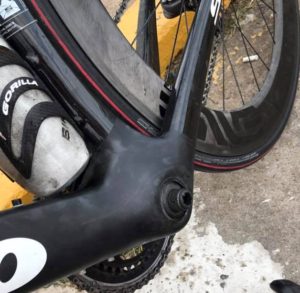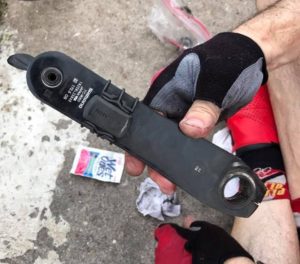Really, I don’t want to be the guy that spreads pictures of mechanical failures like it’s raining broken bikes. A lot of people experience trouble-free riding. But…
…my good friend Pierre sent me these pictures of a 22 mph crankarm removal.
 Note the dutchman from the bearing preload nut, still screwed into the spindle.
Note the dutchman from the bearing preload nut, still screwed into the spindle.
I see several learnings here.
First is the obvious failure – the flange broke off of the bearing preload nut and the crankarm came off of the spindle. That nut was supposed to keep the crankarm on, right? No, not really. The only purpose of that lightweight nut is to eliminate lateral play in the crank / bottom bracket interface before you tighten the pinchbolts. It’s functionally like the top cap on your headset. I must admit that until I saw these pictures I thoughtlessly assumed that it was also a secondary retention mechanism. But, slap my forehead, it’s plastic! It is not structural.
The 5mm pinch bolts (“Crankarm Fixing Bolts” in Shimano parlance) are what keep the crank together.
I like Shimano’s pinchbolt crank retention design. 12-14 nm on 5mm pinchbolts is easier to achieve and maintain than 25 or more nm on a tapered spindle design, and it’s less likely to work loose and/or make noise than a tapered spindle interface (in my experience).
Did you ever read the Shimano TechDoc for their cranksets. Quoting:
The two left crank arm fixing bolts should be tightened at the same time rather than each fully tightened separately. A torque wrench should be used to check that the tightening torques are within the range of 12 – 14 N·m {105 – 122 in. lbs.}. Furthermore, after riding approximately 100km (60 miles), use a torque wrench to re-check the tightening torques. It is also important to periodically check the tightening torques. If the tightening torques are too weak or if the mounting bolts are not tightened alternately in stages, the left crank arm may come off and the bicycle may fall over, and serious injury may occur as a result.
I mean, who re-torques their crank bolts after 60 miles and periodically?
I think it’s really cool that the tolerance between the spindle ID and bearing preload nut is such that you can’t turn the nut after you tighten the pinch bolts. But that led me down an erroneous path of thinking that the nut constituted a secondary retention mechanism. As illustrated in the failure photo it clearly lacks the strength to do any such thing.
If the nut is not a valid secondary retention mechanism, the pin on the little plastic tab – what Shimano calls a “Stopper Plate” – between the pinchbolts surely is not. I’m not really clear on the function of that little tab. I know the pin on the tab drops into a hole in the spindle. Maybe it is an indicator that the crankarm is in the proper lateral position???
So it all comes back to proper torque on the pinch bolts. This is one place I always use a torque wrench (the others being anything that clamps onto carbon). I am also very careful to use a good 5mm head and insert it fully so as not to strip the bolts out. Sometimes this requires that I clean dirt out of the bolts with a pick before inserting my wrench. Rounding out one of those bolts would be the start of a bad day.
Hey Shimano, those pinchbolts would be a great place to use Torx bolts!
By the way, I had a crankset from another manufacturer that used the pinchbolt design, but the spindle didn’t cinch down on the bearing preload nut. I had to regularly – every hundred miles or so – stop and re-tighten the bearing preload nut or it would back out until it hit my ankle. I eventually drilled a small hole in the flange of the nut and safety-wired it in place. I was under the apparently false assumption that it would have prevented the crankarm from coming off if the pinch bolts loosened up.
So grab your torque wrench and go check your crank!
I refuse to discuss the JRA (Just Riding Along) failure of a titanium frame, pictures of which Pierre also sent me.
Tailwinds
Killa

